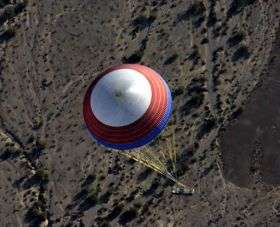NASA Conducts Second Test of Main Parachute for Ares Rockets

NASA and industry engineers successfully tested the main parachute for Constellation Program rockets during a drop test Thursday at the U.S. Army's Yuma Proving Ground near Yuma, Ariz.
The parachute system will allow Ares I and Ares V first stage boosters to be recovered and reused. Thursday's test validated the results of an earlier test conducted in September.
"Measuring 150-feet in diameter and weighing 2,000 pounds, this is the biggest chute of its kind that's been tested," said Steve Cook, director of the Ares Projects Office at NASA's Marshall Space Flight Center in Huntsville, Ala. "With each milestone, we bring ourselves one step closer to further exploring the moon."
Exploring the moon and beyond is the focus of the Constellation Program, which is developing a new family of U.S. launch vehicles, spacecraft and related systems for exploration.
Booster recovery was the focus of the recent test, the second in a series. Outfitted with a 42,000-pound weight to simulate the load of a rocket's first stage, the main parachute was dropped from a U.S. Air Force C-17 aircraft flying at an altitude of 16,500 feet. The 1-ton parachute and all supporting hardware functioned properly, landing safely approximately three minutes later on the Yuma Proving Ground test range.
During the first main parachute test on Sept. 25, the parachute was dropped from a slightly higher elevation of 17,500 feet, giving NASA engineers the opportunity to monitor parachute performance at a dynamic pressure of 86 pounds per square foot. After the drop's completion, engineers spent several weeks reviewing test data - measuring the parachute's peak loads at opening, determining the canopy expansion rate during the early phase of inflation and measuring the parachute's drag area as it drifted down to Earth.
The Ares first stage booster recovery system is derived from the system NASA uses to recover the space shuttle's solid rocket boosters after launch. The first stage booster for Ares I is similar to the space shuttle's solid rocket booster but has an added fifth segment of propellant, resulting in a heavier load.
The current parachute tests are necessary to allow for differences between the space shuttle's four-segment boosters and the Ares launch vehicles. Testing is scheduled to run through 2010.
ATK Launch Systems near Promontory, Utah, is the prime contractor for the first stage booster. ATK's subcontractor, United Space Alliance of Houston, is responsible for the design, development and testing of the parachutes at its facilities at NASA's Kennedy Space Center, Fla.
Source: NASA





















